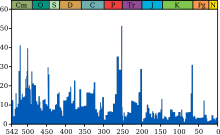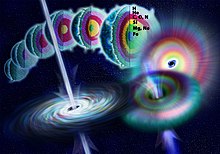Ordovician mass extinction

The Ordovician mass extinction occurred towards the end of the Ordovician about 450 to 440 million years ago and is one of the largest mass extinctions in the history of the earth, both in terms of the proportion of the extinct genera and in relation to the total loss of individuals.
Two extinction waves probably occurred between 450 and 440 million years ago, one million years apart. At that time, the habitat of all known life forms was limited to the seas and lakes. About 85% of the species, 60% of the genera and 26% of the families of all marine species became extinct, including two thirds of all armpods and moss animals ; also clams , echinoderms and corals were heavily affected.
The cause of the mass extinction appears to have been the movement of Gondwana , which drifted into the South Pole region . The accompanying icing led to a drop in sea levels and global cooling. With falling sea levels, habitats were lost in the shallow lake districts along the continental shelf and connections between spaces were broken. Evidence of the icing was also found in sediments discovered in the Sahara. The main reason for the mass extinction in the Upper Ordovician is seen in the following combination of lowering sea levels and cooling of the global climate .
context
The extinction took place about 443 million years ago, as documented by finds from the Upper Ordovician , and marks the boundary between the Ordovician and the Silurian that followed . In the previous period of the Ordovician, the hitherto most important biodiversity in the history of the earth had developed. In the period between 440 and 450 Ma before today, several pronounced changes in the isotopic composition of oxygen and carbon occurred, which indicate biologically caused changes. This complexity could indicate several individual, closely spaced events or several phases within an event. At that time the most complex multicellular organisms lived in the seas. About 100 marine families became extinct, which corresponds to about 49% of the species of fauna . Mussels , echinoderms , trilobites , conodonts and graptolites were decimated . Statistical analyzes suggest that the loss of marine life occurring at this time was more due to an increase in the rate of extinction than to a decrease in speciation .
Possible causes

These extinction events are the subject of intensive research. The extinction highlights correspond to the beginning and end of the heaviest ice age of the Phanerozoic . It marks the end of a long cooling trend in the brain antium at the end of the Ordovician, when greenhouse conditions typically prevailed.
The event was preceded by a drop in atmospheric carbon dioxide concentration, which primarily affected the shallow water areas of the seas where most of the organisms lived. When the southern supercontinent Gondwana drifted over the South Pole, ice caps formed on it.
The rock layer belonging to the event was found in North Africa and in the then adjacent northeast of South America in rock sequences of the late Ordovician, which was then at the South Pole. Freezing binds water in the world's oceans, while interglacials release it. This caused repeated rise and fall in sea levels; the vast, intra-continental Ordovician shallow seas disappeared, eliminating many ecological niches . When they returned, they were colonized by founder populations that lacked many families of organisms. With the next pulse of glaciation, these also disappeared, which further reduced the biological diversity each time. In the strata of North Africa, Julien Morneau reported five glaciation pulses in seismic sections.
This went hand in hand with a shift in the places where groundwater originated. They were shifted from greenhouse warm low latitudes to higher latitudes, which were, however, characterized by colder conditions. This increased the deep water currents and the enrichment of the soil water with oxygen. For a short time an adapted fauna thrived there before anoxic conditions returned. The collapse of oceanic circulation patterns brought nutrients up from the deep sea. Surviving species were those that could cope with the changed conditions and fill in the ecological niches left by the extinction events.
Gamma-ray burst

Illustration of a massive star collapsing into a black hole. The released energy in the form of jets along the axis of rotation forms a gamma-ray burst.
A small minority of scientists have suggested that the initial extinction events were caused by a gamma-ray flash from a hypernova within 6,000 light-years of Earth (from an adjacent spiral arm of the Milky Way ). A ten-second eruption would have destroyed half of the earth's ozone layer suddenly. Organisms that lived near the earth's surface - including plants - would have been exposed to intense ultraviolet radiation. While the hypothesis agrees with the pattern of the onset of the extinction event, there is no clear evidence that there has ever been a gamma-ray burst near Earth.
Volcanism and weathering
Recent research suggests a role for volcanism and the greenhouse gas CO 2 . Outgassing due to intense volcanism in the Ordovician was offset by heavy weathering of the rising Appalachian Mountains , which removed carbon dioxide from the atmosphere. In the brain , volcanism receded and the ongoing weathering caused a significant and rapid decrease in the concentration of carbon dioxide. This correlates with the sudden and short ice age.
End of the event
The end of the second event occurred when melting glaciers caused sea level rise again and this stabilized. The recovery of the diversity of life with the renewed flooding of the continental shelves at the beginning of the Silurian also brought increased diversity within the surviving orders .
literature
- Felix Gradstein, James Ogg, Alan Smith (Eds.): A Geologic Time Scale 2004 . Cambridge University Press, 2004.
- A. Hallam, Paul B. Wignall: Mass extinctions and their aftermath . Oxford University Press, 1997.
- Barry D. Webby, Mary L. Droser (Eds.): The Great Ordovician Biodiversification Event . Columbia University Press, 2004.
Web links
- Jacques Veniers, "The end-Ordovician extinction event" : abstract of Hallam and Wignall, 1997.
Individual evidence
- ^ A b c R. V. Sole, M. Newman: Extinctions and Biodiversity in the Fossil Record - Volume Two, The earth system: biological and ecological dimensions of global environment change. In: Harold A. Mooney, Josep G. Canadellin (Eds.): Encyclopedia of Global Environmental Change. John Wiley & Sons, Chichester 2002, ISBN 0-471-97796-9 , pp. 297-391.
- ↑ a b extinction . Retrieved October 16, 2013.
- ↑ David Jablonski, WG Chaloner: Extinctions in the Fossil Record [and Discussion] . In: Philosophical Transactions of the Royal Society of London B: Biological Sciences . tape 344 , no. 1307 , 1994, pp. 11-17 , doi : 10.1098 / rstb.1994.0045 .
- ↑ a b Axel Munnecke, Mikael Calner, David AT Harper, Thomas Servais: Ordovician and Silurian sea – water chemistry, sea level, and climate: A synopsis . In: Palaeogeography, Palaeoclimatology, Palaeoecology . tape 296 , no. 3–4 , 2010, pp. 389-413 , doi : 10.1016 / j.palaeo.2010.08.001 .
- ^ Robert A. Rohd, Richard A. Müller1, RA Muller: Cycles in Fossil Diversity . In: Nature . 434, No. 7030, 2005, pp. 208-210. bibcode : 2005Natur.434..208R . doi : 10.1038 / nature03339 . PMID 15758998 .
- ↑ RK Bambach, AH Knoll, SC Wang: Origination, extinction, and mass depletions of marine diversity . In: Paleobiology . 30, No. 4, December 2004, pp. 522-542. doi : 10.1666 / 0094-8373 (2004) 030 <0522: OEAMDO> 2.0.CO; 2 .
- ↑ Cesare Emiliani : Planet Earth: Cosmology, Geology, & the Evolution of Life & the Environment . Cambridge University Press, 1992 ISBN 0-521-40949-7 , p. 491 (paperback edition).
- ↑ [1] (PDF; 1.1 MB) IGCP meeting September 2004 reports pp 26f
- ↑ Christopher Wanjek: Explosions in Space May Have Initiated Ancient Extinction on Earth . NASA. April 6, 2005. Retrieved April 30, 2008.
- ^ Ray burst is extinction suspect , BBC. April 6, 2005. Retrieved April 30, 2008.
- ↑ AL Melott et al : Did a gamma-ray burst initiate the late Ordovician mass extinction? . In: International Journal of Astrobiology . 3, No. 2, 2004, pp. 55-61. arxiv : astro-ph / 0309415 . bibcode : 2004IJAsB ... 3 ... 55M . doi : 10.1017 / S1473550404001910 .
- ↑ AL Melott, BC Thomas: Late Ordovician geographic patterns of extinction Compared with simulations of astrophysical ionizing radiation damage . In: Paleobiology . 35, 2009, pp. 311-320. arxiv : 0809.0899 .
- ↑ Qing Gong et al. a .: Mercury spikes suggest volcanic driver of the Ordovician-Silurian mass extinction . In: Scientific Reports . tape 7 , no. 5304 , July 13, 2017, doi : 10.1038 / s41598-017-05524-5 .
- ^ SA Young et al : A major drop in seawater 87Sr / 86Sr during the Middle Ordovician (Darriwilian): Links to volcanism and climate? . In: Geology . 37, No. 10, 2009, pp. 951-954. doi : 10.1130 / G30152A.1 . Retrieved January 5, 2010.
